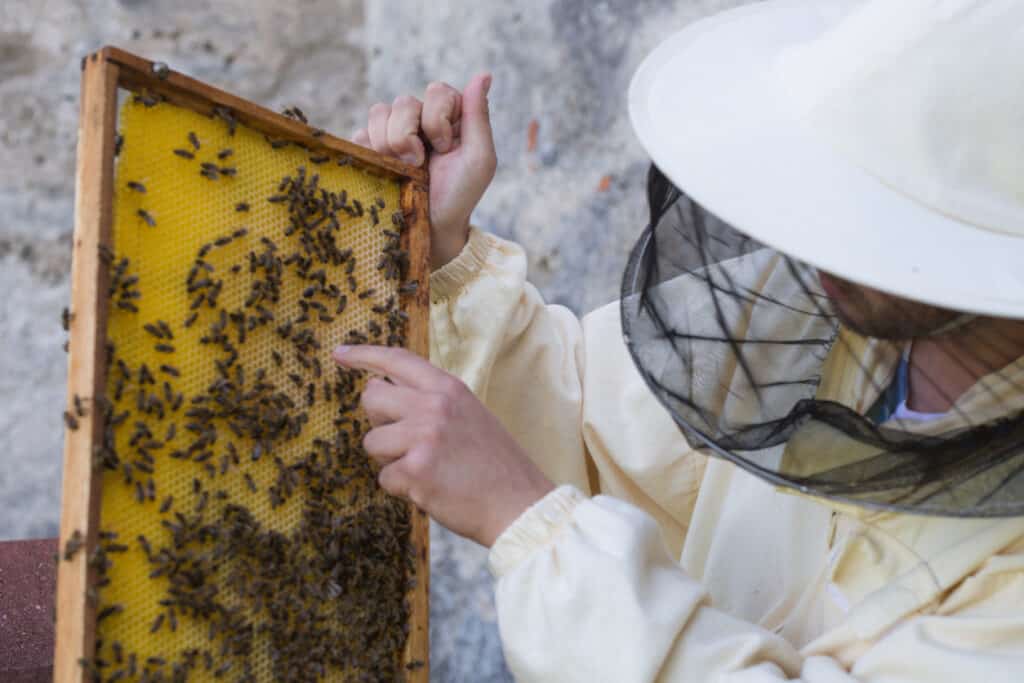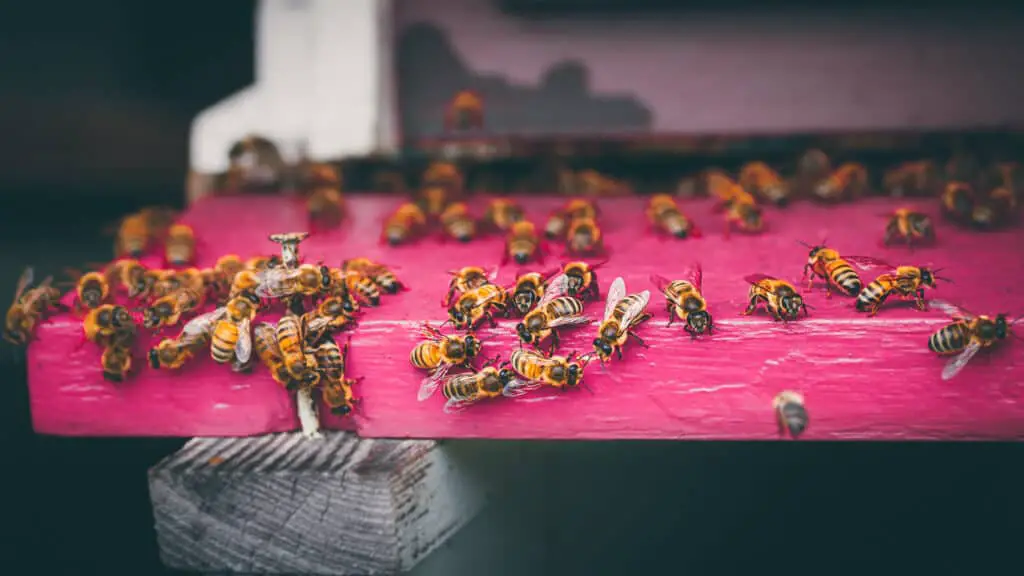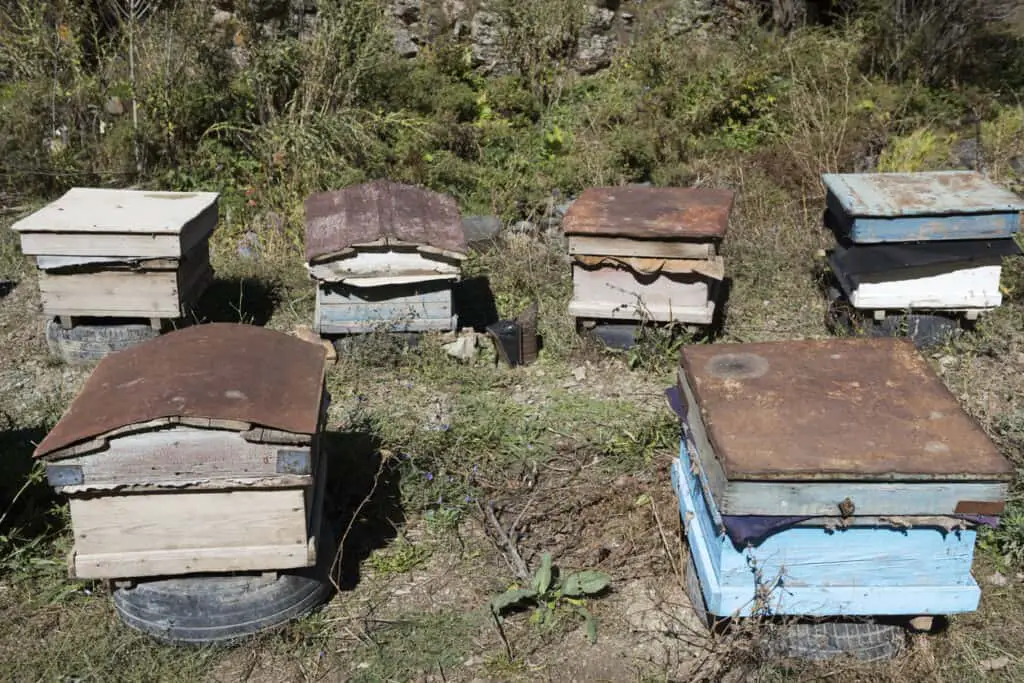Beehives are one of nature’s wonders, and their complexity and functionality have bewildered and amazed scientists for centuries. One of the burning questions finally answered was why the hive is hexagonally shaped.
Beehives are hexagonal as this shape provides the most efficient use of space and the most storage space while using the least amount of wax for their construction. The hexagonal shape also means that the queen’s eggs and the pollen and honey collected can be efficiently stored.

Bees have an exceptional understanding of efficiency in everything they do, and the beehive is an excellent example of this on multiple levels, using one of the nature’s most effective designs to optimize their living, breeding, and food storage -so let’s get up close and personal with the beehive!
The Honeybee Conjecture

While you may think that we have only recently begun investigating the origins and reasons behind the use of the hexagon in beehives, this intriguing problem was first addressed more than 2000 years ago!
In 36 BC, a Roman scholar named Marcus Terentius Varro began pondering the reason behind the hexagonal structure of the beehive. His hypothesis was based on the proposal that hexagons break up and utilize flat space better than other shapes and use less honey to make them.
The honeycomb conjecture potulated by Varro states that a regular hexagonal grid or the honeycomb is the best method to divide a surface into regions of equal area with the least total perimeter.
Varro never took the time to prove his theory, which is why it is known as the ‘Honeybee Conjecture.’ Still, more than 2000 years later, a scientist at the University of Michigan proved mathematically that Varro’s conjecture was accurate.
Thomas Hales proved that the hexagonal tiling provides the way with the least perimeter to house and contains an infinite number of unit areas. He further confirmed that while the effect of bulging out is advantageous for space, the converse of bulging in is not.
This led him to advise that polygon shapes could also be practical; the hexagonal shape is the optimal configuration for space and resource efficiency. Now that we have the brain-bending stuff out of the way let’s get a little more personal with the beehive.
Why Is The Hexagon The Best Option For A Beehive?

Recent research and insight into why the bees use the hexagon for their hives have revealed the answer mathematically; of course, the bees knew this all along; we humans just had to catch up with them.
The hexagon shape delivers the most space and available surface area using the least amount of material to construct it. This is important as the wax needed to build the beehive is very labor-intensive and takes a lot of honey and pollen to produce.
Because the worker bees that make the hive have limited lifespans, they need to achieve maximum productivity. The hexagon is the most efficient symmetrical structure for the beehive to accomplish its essential functions.
Beehives Are Hexagonal As They Are Energy Efficient For Workers
By saving energy in the building of the hive using the hexagonal structure, worker bees can then utilize that energy in another vital function – pollination. Energy saved in building means they can expend more energy in transferring pollen between flowers, thereby ensuring the continuation of the food chain for the planet.
Considering the amount of work involved in creating one teaspoon of honey and that a single ounce of wax would require six US teaspoons of honey, the more efficient the shape of the honeycomb, the less honey is used, and more can be utilized for other vital activities in the hive.
Hexagonal Beehives Provide Optimal Surface Area, Space & Structural Strength
Considering the number of individual bees in the hive and the requirements for storing eggs, honey, and pollen, it would be vital for the structure to deliver optimal space. Only the hexagon structure can offer this.
Another crucial element in the structure of the beehive is strength; the hexagonal shape is ideal for maintaining its structural integrity. The hexagon’s sides fit perfectly together and seal together to create an airtight environment.
The Beehive Is Hexagonal To Optimise The Internal Temperature
Another vital aspect of beehive health is the temperature and having an airtight, insulated structure is non-negotiable as this ensures the sustainability of the hive.
Wax is an excellent insulator and waterproof sealant and, when laid out in hexagonal blocks, provides the perfect material for a strong, resilient, waterproof, and insulated structure. The hexagonal structure allows for the structural forces within the hive to be evenly dissipated and not have any one part of the hive supporting more weight than another.
Not only does the hexagonal honeycomb provides an optimum living area, but it also provides a precisely controlled thermal insulation system that the bees use to control the temperature within the hive.
If the temperature were too hot, the wax would melt, the entire structure would fail, resulting in exposure to predators, and the vulnerable young bees, pupae, and larvae would probably die due to the extreme heat.
On the other side of the heat scale, allowing too much air would reduce the internal temperature. The wax would be challenging to work with, more energy would be needed to create it, and bees would have to work much harder to maintain the optimum temperature.
As with the overheating scenario, the effect of cold on young bees, larvae, and pupae would be catastrophic, and the amounts of honey needed to create the wax would be unrealistically high and grossly inefficient.
Much like the earth is in the habitable zone from the sun where the temperature is not overly hot or too cold but at just the right level for life to exist , the hexagonal design of the beehive provides the perfect environment for the hive to thrive.
How Is The Honeycomb Made?
To understand why beehives are hexagonal a little better, we need to learn a bit more about what it takes to build a beehive.
The sole construction material is wax secreted from glands on the bees’ abdomens. As the wax is produced, it is added to the honeycomb structure, which builds this hive. To make one ounce of wax, a bee must consume the equivalent of two tablespoons of honey.
When you think that a honeybee will only produce about ½ teaspoon of honey in its lifetime, you know why they need to use the most efficient shapes possible when building their hive.
That statistic alone demonstrates the need for the most efficient structural shape possible – consider the size of an average bee against the volume of two tablespoons of honey! That’s a lot of energy needed to make one ounce of wax!
Bees use the heat from their bodies to melt the wax and then convert it from a circular shape into the hexagon shape we see as the finished product. So the beehive cells don’t start as hexagonal; they are ‘melted’ into that shape.
As the wax dries in the hexagon shape, the cells come together to form the beehive. While some parts of the hive will store honey and pollen, other factors are used for the queen’s eggs, and when those hatch, the cells become home to the young bees until they are old enough to assume their role and actively participate in the hive routine.
Why Aren’t Circles, Triangles, Or Squares Used For Beehives?
You may ask why not use triangles or squares as these would also offer a tight-fitting and airtight matrix, but the six-sided option provides the most efficient use of space, surface area, and energy to build.
Right-angled triangles, squares, and hexagons are the only three shapes in nature that can provide an airtight interconnected structure. Still, out of those three, the hexagon offers the most surface area, volume, and tensile strength.
When looking at why beehives are shaped hexagonally, you need to evaluate the number of cell walls that can be connected and shared using any particular shape. This aspect determines the structural strength, the overall surface area, and the number of cells that can be created with the least amount of material.
Considering a circle will leave a gap between each cell, the number of connected cells would be much lower than in a linear-type shape. While the circle offers optimum efficiency in other applications in nature, it is unsuitable for the fundamental structure of the beehive.
Using a triangle presents the same problem. While the sides would be sealed, the number of cell walls in contact with each other would be half the number of those with a hexagon.
This would require double the number of resources compared to the hexagon meaning more honey would need to be made and consumed to provide 50% less structure – even in our world, this would not be viable, and the bees know this too!
Let’s look at the square. While this would give four walls to connect the cells with, it still doesn’t deliver the same quantity of cell wall connections the hexagon does, and, as such, the energy and resource requirements would be higher by around 33%.
Because bees don’t have a long lifecycle, they need to maximize their time and use of resources to deliver optimum results. While we may never truly understand how they know the hexagon is the most efficient shape, they simply do!
The Hexagonal Beehive Offers The Most Efficient Living Quarters
Aside from honey production, the honeycomb’s hexagonal design perfectly fits the bee’s body’s shape. Certain areas of the hive are used to house the queen, the workers, and the pupae and larvae.
The hexagonal shape and depth of the cells are perfect for the bee’s body shape and allow the young and developing bees to live with space and insulation to regulate their temperatures while they are still growing.
The square or triangle would leave too much space within the cell, which would be a waste of space in an environment where hyer-efficiency is the order of the day. For a civilization whose workers have relatively short life cycles, there can be no wastage of resources, and the hexagonal-shaped beehive ticks every box regarding efficiency.
Intelligent little things, aren’t they? Not bad for an insect that defies the laws of flight and aerodynamics, in addition to having a more excellent knowledge of geometrical engineering than we do!
Humans Use Hexagons In Our Engineering!
The skill and expertise of the honey bees have led humans to copy them in many of the engineering structures we have built on earth. We use this very same design when building planes, cars, and bridges, and we now understand that the hexagon shape enhances the strength of materials in this matrix form.
Some more common examples of this shape in everyday life are pencils before they are sharpened! Considering how uncomfortable it would be to use a round or square-shaped pencil over the standard hexagonal-shaped one, you can understand why this shape is so efficient!
The standard nut, used on bolts to tighten them and secure metal pieces, is a hexagon, as are snowflakes, stop signs, soccer ball segments, military medals and emblems, clocks, and city and town planning segments use hexagons to maximize spatial divisions too.
Hexagons are also used in mechanical and chemical engineering, biomechanics, and nanofabrication, which incorporate applications in the aerospace, medical, and IT industries. This design has even found its way into snowboards!
If you look at some of our most advanced technology, like the new Webb space telescope that uses an array of super-precise mirrors to provide the most detailed images of the Universe to date, those mirrors are hexagonal too!
Conclusion
We have shown that the reason why beehives are hexagonal has been mathematically proven to be the most efficient in terms of offering maximum surface area with the least perimeter and, therefore, the primary option in terms of efficient construction and internal strength, and space utilization.
Beehives are hexagonal shaped as they inherently know that this is the optimum shape for all-round efficiency and offers the best structure for the hive to survive, produce honey and maintain the bee population in the environment.
Resources
https://www.maa.org/frank-morgans-math-chat-hales-proves-hexagonal-honeycomb-conjecture
https://www.nwpb.org/ask-dr-universe/why-do-bees-make-hexagons-in-their-hives
https://www.sciencefriday.com/educational-resources/why-do-bees-build-hexagonal-honeycomb-cells/

